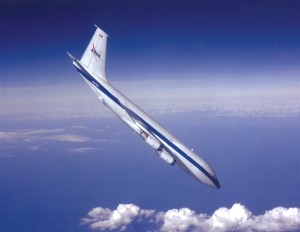By Bob Shane
The last KC-135A aircraft that NASA used for weightless training and research in a microgravity environment was retired after making its final operational flight on October 29. Known as “Weightless Wonder V,” it was one of five KC-135A flying laboratories that the Space Agency operated over the years, since the Reduced Gravity Program began in 1957 at Wright Patterson Air Force Base. Additionally, it was the only “A” model KC-135 still flying in the world.
Also designated as NASA 931, the aircraft’s final flight lasted nearly three hours, during which 50 parabolas were flown. In its lifetime, a total of 34,700 parabolas were recorded. Astronauts Steve Robinson and Soichi Noguchi, who are scheduled to be part of the crew on the next Shuttle mission, were on board.
In the nine years that the aircraft was based at Ellington Field near Houston, it has flown 2,000 hours, accumulating almost 200 hours of weightlessness. Over 2,000 college students have flown aboard the aircraft as part of the Reduced Gravity Student Flight Opportunities Program, which enables them to design and conduct their own experiments in weightlessness. Other missions flown by NASA 931 included transporting critical space hardware and helping to move the space shuttle by flying as an advance scout ahead of the shuttle attached to its B-747 carrier.
When 931 completed its last operational flight for NASA on October 29, it was thought that its final flight would be from Ellington Field to Davis-Monthan Air Force Base in Tucson. There it would land and taxi into the Aerospace Maintenance and Regeneration Center, the facility where military and government agency airplanes go to be stored or parted out. Fortunately, it has become a new and welcome addition to the collection of aircraft on display at the Pima Air & Space Museum. On December 10, the KC-135A landed at Davis-Monthan at 10:26 am, smoking its tires for the last time. The aircraft was subsequently towed off base, across Valentia Road, onto museum property, where it has joined aircraft that comprises one of the world’s largest non-governmental aerospace museums.

Researchers on board the KC-135 aircraft rehearse extravehicular activity tasks for repairing damaged shuttle tiles.
“We’re thrilled to acquire the Boeing KC-135, an aircraft that represents an important part of the history of modern aircraft, and we greatly appreciate the assistance of NASA in helping us through this process as well as getting the plane to Tucson to join the museum’s collection of over 250 aircraft,” said Scott Marchand, director of collections and aircraft restorations at PASM.
While it’s the end of an era for the KC-135A, it’s not the end of NASA’s Reduced Gravity Program. The next “Weightless Wonder” is a C-9 the agency acquired from the Navy. Designated NASA 932, “Weightless Wonder VI” is currently undergoing modification and will commence weightless operations some time in 2005.












